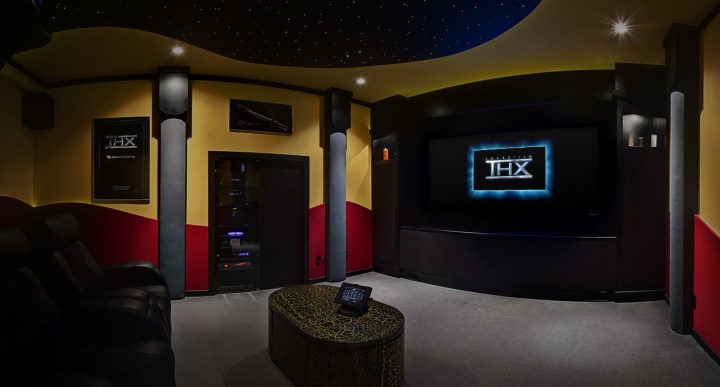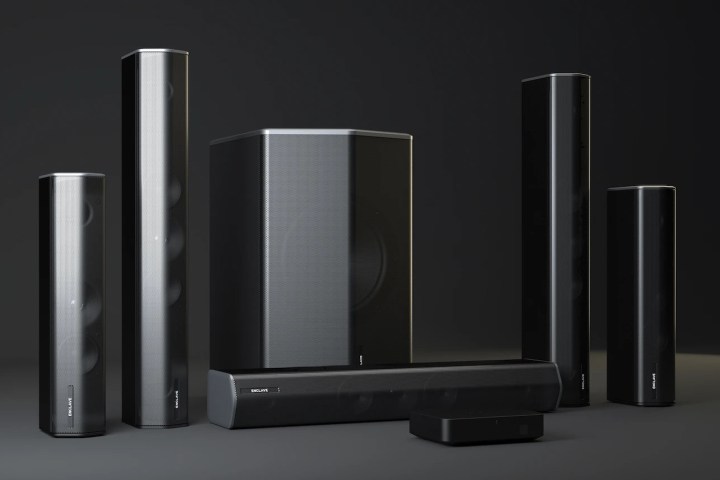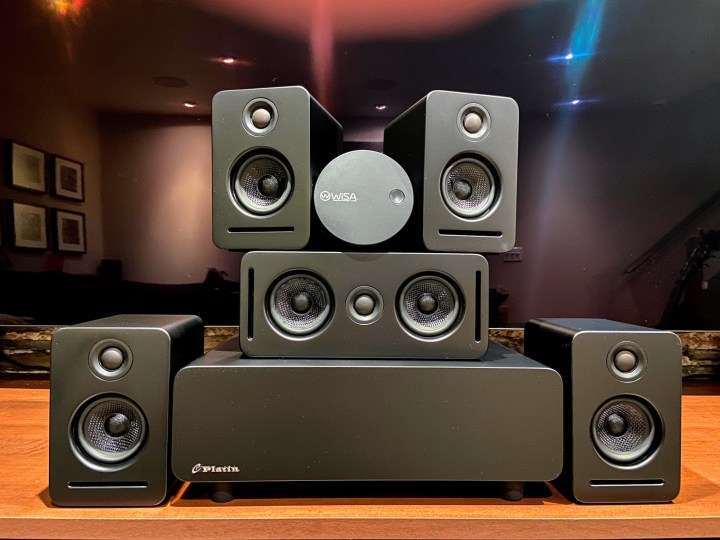Decades after it first boomed into theaters with its iconic, ear-splitting crescendo, THX remains a bit of an enigma for most of the public. We conducted an informal survey of some of our tech-aware (but not necessarily tech-savvy) acquaintances, asking if they knew what THX was or what it did. Answers involved everything from “TH-who?” to “that company that has the cool-sounding trailers before movies.” Some managed to get a little closer, suggesting that THX was the best sound format — closer, but not quite right.
While laypeople may associate the company with its trailers and shiny badges, there’s a lot more going on behind the scenes. THX doesn’t make the stuff you see and hear, but it does a lot of things that — directly and indirectly — make what you see and hear better. Because THX works its magic outside of the spotlight, few people understand how or why the company does what it does. That’s a bit unfortunate since much of THX’s little-known work is just plain cool.
But to better appreciate where the company is and where it’s going, it helps to first understand where it’s been.

One of George Lucas’ better ideas
THX was born in the early 1980s when George Lucas — the creator (and some say “destroyer”) of the Star Wars franchise — decided he wanted to ensure Return of the Jedi looked and sounded exactly as he intended it to in as many theaters as possible. Tomlinson Holman, an audio engineer and technical director for Lucasfilm at the time, was assigned the task of making that happen.
… anything that could potentially pull a viewer out of the magic of the film needed to be mitigated.
Holman was apparently dismayed when he surveyed the state of theaters at the time. Most of these cinemas hadn’t seen any updates since World War II. Images looked shoddy, and the sound was terrible. All the work and money that Hollywood poured into making movies look and sound amazing was being lost — nay, obliterated — in these dilapidated theaters. Holman’s mission suddenly had a clear focus: Make the movie-going experience as good as it can possibly be; let people see and hear films as the directors intended them to be seen and heard.
Holman set about developing a set of standards that would deal with most of the issues plaguing those aging theaters. While Holman couldn’t do anything about obnoxious people and sticky floors, he could develop a plan to address other problems, such as outside noise bleeding in, inside noise generated by environmental controls, excessive reverb, inadequate sound, poor image brightness, poor viewing angles, and so forth. In short, anything that could potentially pull a viewer out of the magic of the film needed to be mitigated. The resulting set of standards was referred to as THX — a hybrid of Tom Holman eXperiment and Lucas’ feature-length directorial debut, THX1138.
THX’s home invasion

Over the next ten years or so, THX refined its standards to a remarkably granular level — a process that continues to this day — and began folding those standards into its theater certification program. Colloquialisms like “raising the bar” and “kicking it up a notch” don’t adequately describe the direction THX was taking the movie-going experience at the time. It was writing the handbook on reproduction of video and sound.
THX researchers dealt with everything from how many speakers were needed per cubic foot of space to how many degrees Kelvin colors needed to measure in order for a picture to be considered accurate. Even if you see movies in a non-THX-certified theater today, you still have THX to thank for the quality of picture and sound you experience because the company showed the world just how good the movie experience could be. Once it had, standards began to skyrocket across the board.
But changing the way people saw movies at the theater wasn’t enough for THX. In a bid for total global domination (we might be exaggerating a little), THX began work on an entirely new program centered around home theater equipment certification. This was a tricky proposition because home theaters are a far cry from commercial theaters, where everything from the picture to the sound to the size of the space is much bigger. THX had to figure out how to ensure that the big-theater experience would get delivered in the home. So, it built a home theater at its facilities, armed it with a bevy of extremely advanced electronics, and got to researching.
It created a specification for performance and developed software for the post-processing side that helped translate the cinema experience to the home experience through a modification of the actual movie soundtrack.
It eventually created a set of standards for home audio gear along with a testing regimen for assessing how well manufacturers had managed to meet these standards. Instead of telling companies how to make products that meet these standards, THX offered its advice and help. For companies that seek to create THX Certified equipment, THX gets involved as early as the development stage and partners with the product and engineering teams all the way through tuning to final certification.
Beyond meeting THX’s standards for performance, THX-certified A/V receivers possess special THX listening modes, like THX Cinema, THX Game, THX Music, and THX Surround EX. As their names suggest, they’re designed to create optimized mixes based on the content or activity you’re engaged with.
But THX’s move into consumer products has been an uphill battle. Expensive to acquire, THX badges were initially found only on high-end equipment, and the prohibitive cost was a turn-off for budget-minded buyers. Plus, many receivers sounded great without THX’s processing. To this day, “Is THX worth it?” remains one of the more commonly asked questions in AV forums.
Many don’t see THX certification as necessary because there are plenty of high-quality sound equipment options — such as A/V receivers and speakers — that sound excellent without THX certification. Some even exceed THX standards but don’t seek certification because they don’t pay the company to evaluate products that they know are up to snuff. But THX never saw itself as an insurance policy for excellence, nor have its efforts been aimed at creating a sound signature that people liked more.
But just by setting a performance standard, THX indirectly encouraged consumer electronics makers to up their game.
Tuned by THX

For companies that want to develop products on their own but also want to take advantage of THX’s expertise, there’s an alternative to full certification: The Tuned by THX program. The chart below illustrates the differences between full certification and “tuning,” which really boils down to THX’s involvement, or lack thereof, in the initial production process.
For full certification, THX must be consulted during the development stage so that the company can ensure that the methodologies and technologies being used meet its standards. If a product has been Tuned by THX, that simply means it has been tested and optimized by the company’s audio engineers.

THX Spatial Audio
Even when THX isn’t working directly with audio tech from other companies, it’s still finding creative ways to enhance your listening experience. The company recently developed THX Spatial Audio, which it claims can use your headphones to transform your run-of-the-mill laptop into a 5.1 or 7.1 surround sound system — all for just $20. The surround sound application is available for Windows 10 and is a standard feature on the Razer Book 13 laptop.
If you’re wondering what makes Razer so special, the Singaporean-American outlet acquired THX back in 2016 and wasted no time in taking advantage of the company’s cutting-edge audio tech.
Getting into the picture
Audio is not the singular focus of THX’s home theater certification program. THX also certifies display technology, including TVs and projectors, though it has not been quite as successful with its video campaign as it has with its audio division.
A THX-certified display undergoes more than 400 tests to assess and help improve things like color accuracy, panel uniformity, sharpness, and upscaling. The company’s website lists a variety of TVs as THX certified. Most of these are Panasonic models which aren’t sold in the U.S., but its partnership with TCL has yielded some interesting developments.
In conjunction with the TV manufacturer, THX has developed a THX-certified game mode, which ensures that the color, refresh rate, and input lag of your display is fit for the “serious gamer.” While most competitive players opt to play on computer monitors, TCL and THX believe they can deliver comparable performance on a much larger screen.
In Sum
THX isn’t just “that company that made that cool graphic that pops up before the movie starts and gets me all excited” — it is a cutting-edge tech outfit that works tirelessly to bring you the best possible theater (and home theater) experience. Whether or not its certification is obligatory for high-fidelity audio equipment is up for debate, but if you see that stamp of approval, you can be pretty darn sure of the quality of the product that carries it.



